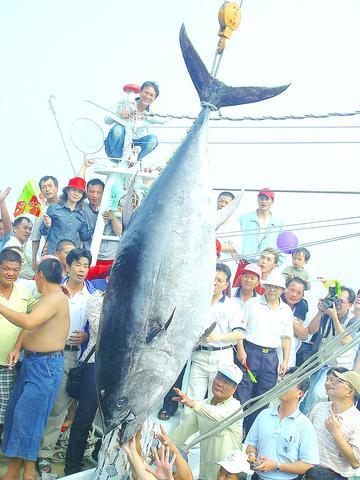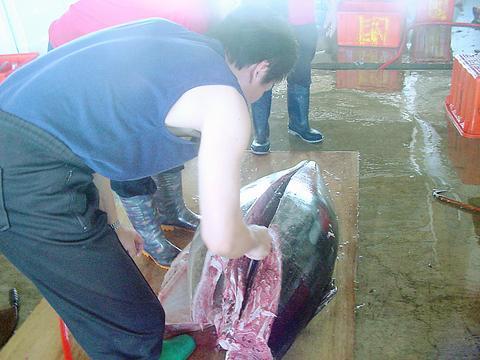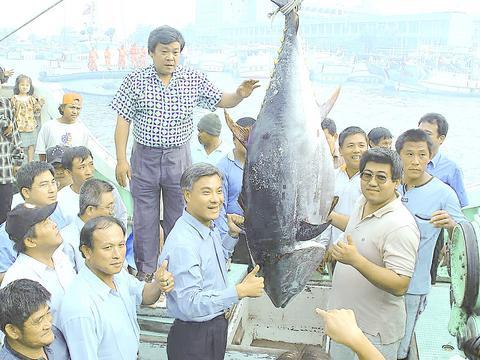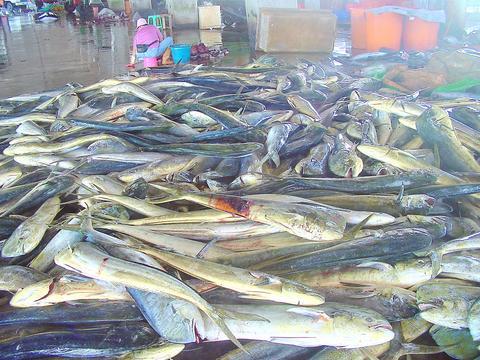Forget SARS. It's tuna season in Tungkang (
Far away from fears of severe acute respiratory syndrome, this southernmost county is holding the "Pingtung Bluefin Tuna Cultural Festival 2003" -- starting yesterday through to June 29 -- in the hope of enticing gourmands and tourists to sample the magnificent fish, which can grow up to 4m in length and weigh up to 500kg.

PHOTO COURTESY PINGTUNG COUNTY GOVERNMENT
In terms of bluefin tuna catching, Taiwan leads the world and this is largely due to use of the latest technologies to catch the fish, said Chang Cheng-ping (

PHOTO: DEREK LEE, TAIPEI TIMES
Around 50,000 people live in Tungkang, comprising Taiwanese, Hakka and Chinese. And, although the population has decreased recently, it is still one of the most important fishing harbors in the country and the epitome of a thriving fishing port. The local fishermen's association is preparing to celebrate its centennial anniversary next month and the restaurant business, in particular, is booming, thanks largely to the conscientious efforts made by the county government since 2001 to promote this annual cultural event.
Tungkang residents say there are plenty of reasons to visit their town, but they are particularly proud of what they call their "three treasures": Namely, the fine-textured bluefin tuna, the tiny and mouth-watering sergesgid shrimp (

PHOTO: DEREK LEE, TAIPEI TIMES
Chang Tai-fang (

PHOTO: DEREK LEE, TAIPEI TIMES
Tuna is extremely healthy and rich in essential fish oils such as DHA (docosahexaenoic acid), which is particularly abundant in brain and retina tissue and is good for cardiovascular health, brain and nervous system function. Even better, though, the fine taste of its rose-pink flesh melts away in your mouth, an impressive sensation which has easily won over numerous Taiwanese and Japanese gourmets over the years.
"I would not miss the taste of it for anything in the world. It is just hard to imagine the feeling of a piece of fish meat melting in your mouth like that ... it's a great feeling, almost funny," Chai Cheng-hsian (
Dubbed by locals the "Black Jug" (
Lin Han-chou (林漢丑), the director of Tungkang fish market and a fisherman of nearly 30 years, said the North Pacific bluefin tuna is found from Green Island all the way up north to Ilan County (宜蘭縣), though bluefin tuna family members can also be found in the seas around Sicily, Italy. Tuna swim in the strong, warm currents of the North Pacific Ocean, or Kuroshio (黑潮), which emerge from around the equator near the Philippines and push northward a variety of fish in different seasons, past the Ryukyu and Kyushu Islands, and into the Japan Sea.
A study published by the Taiwan Fisheries Administration (
This journey takes advantage of the stocks of flying fish, which abound in the sea near Green Island and Orchid Island. It is at this time that bluefin tuna rise from the depths of the ocean and fisherman are able to make an easier catch.
Commenting on this year's tuna catch so far, Lin said that as of May 9, fishermen at Tungkang had caught 695 bluefin tuna, which is far below last year's level of 1,500 in the same period. The reasons for this shortfall, Lin said, are twofold.
First, the lingering typhoon Kujira in late April has resulted in fishing boats idling in port for over a week. Secondly, the Philippines navy detained five fishing boats from Tungkang last year and now no-one is willing to fish the overlapping fishing territory between Taiwan and the Philippines in the Bashi Channel (
Even so, the northward migration of schools of tuna is keeping the fishermen of Tungkang busy. The first bluefin tuna of the year was caught on April 23 and was a 117kg fish which was sold for NT$585,000 (about NT$5,000 per kilogram). Two days later, a 311kg tuna was hooked and sold for NT$2,052,600 (about NT$6,600 per kilogram). The local record for a bluefin tuna is over 450kg with a body length of 3m and was set four years ago. The world record is 500kg and 4m in length.
Sale prices have gone up for the fish and last year 1kg of tuna meat was sold for NT$7,000 at the wholesale fish market at Tungkang, a record until yesterday when President Chen sponsored the opening ceremony and "auctioned" 1kg of fish for over NT$20,000.
The fishermen at Tungkang mostly operate 20-tonne boats set up specifically to catch bluefin tuna, with eight crew. There are up to 550 boats rushing in and out of the harbor each day, on their way to the fishing grounds which are a two- to three-day trip away. To keep the catch fresh, a
fishing boat usually heads back as soon as it catches five fish.
"You know, for each 20-tonnes boat, it costs more than NT$10 million to build. The expense runs up to NT$150,000 for every trip to sea. So, if fishermen can catch five tuna every time, they can basically cover all of their expenses, plus a fair profit. That is why they are so anxious to move out again once the cargo is unloaded at this time of the year," Lin said.
There are, however, hard times in the industry at the moment and Lin estimates the total catch of bluefin tuna this year will be approximately 3,500 fish when the season ends in late June, falling far short of last year's level of 5,300.
Even so, Tungkang's fishermen will set out for years to come in the hope of another monster catch from the deep, as their ancestors did before them.

May 26 to June 1 When the Qing Dynasty first took control over many parts of Taiwan in 1684, it roughly continued the Kingdom of Tungning’s administrative borders (see below), setting up one prefecture and three counties. The actual area of control covered today’s Chiayi, Tainan and Kaohsiung. The administrative center was in Taiwan Prefecture, in today’s Tainan. But as Han settlement expanded and due to rebellions and other international incidents, the administrative units became more complex. By the time Taiwan became a province of the Qing in 1887, there were three prefectures, eleven counties, three subprefectures and one directly-administered prefecture, with

It’s an enormous dome of colorful glass, something between the Sistine Chapel and a Marc Chagall fresco. And yet, it’s just a subway station. Formosa Boulevard is the heart of Kaohsiung’s mass transit system. In metro terms, it’s modest: the only transfer station in a network with just two lines. But it’s a landmark nonetheless: a civic space that serves as much more than a point of transit. On a hot Sunday, the corridors and vast halls are filled with a market selling everything from second-hand clothes to toys and house decorations. It’s just one of the many events the station hosts,

Two moves show Taichung Mayor Lu Shiow-yen (盧秀燕) is gunning for Chinese Nationalist Party (KMT) party chair and the 2028 presidential election. Technically, these are not yet “officially” official, but by the rules of Taiwan politics, she is now on the dance floor. Earlier this month Lu confirmed in an interview in Japan’s Nikkei that she was considering running for KMT chair. This is not new news, but according to reports from her camp she previously was still considering the case for and against running. By choosing a respected, international news outlet, she declared it to the world. While the outside world

Through art and storytelling, La Benida Hui empowers children to become environmental heroes, using everything from SpongeBob to microorganisms to reimagine their relationship with nature. “I tell the students that they have superpowers. It needs to be emphasized that their choices can make a difference,” says Hui, an environmental artist and education specialist. For her second year as Badou Elementary’s artist in residence, Hui leads creative lessons on environmental protection, where students reflect on their relationship with nature and transform beach waste into artworks. Standing in lush green hills overlooking the ocean with land extending into the intertidal zone, the school in Keelung